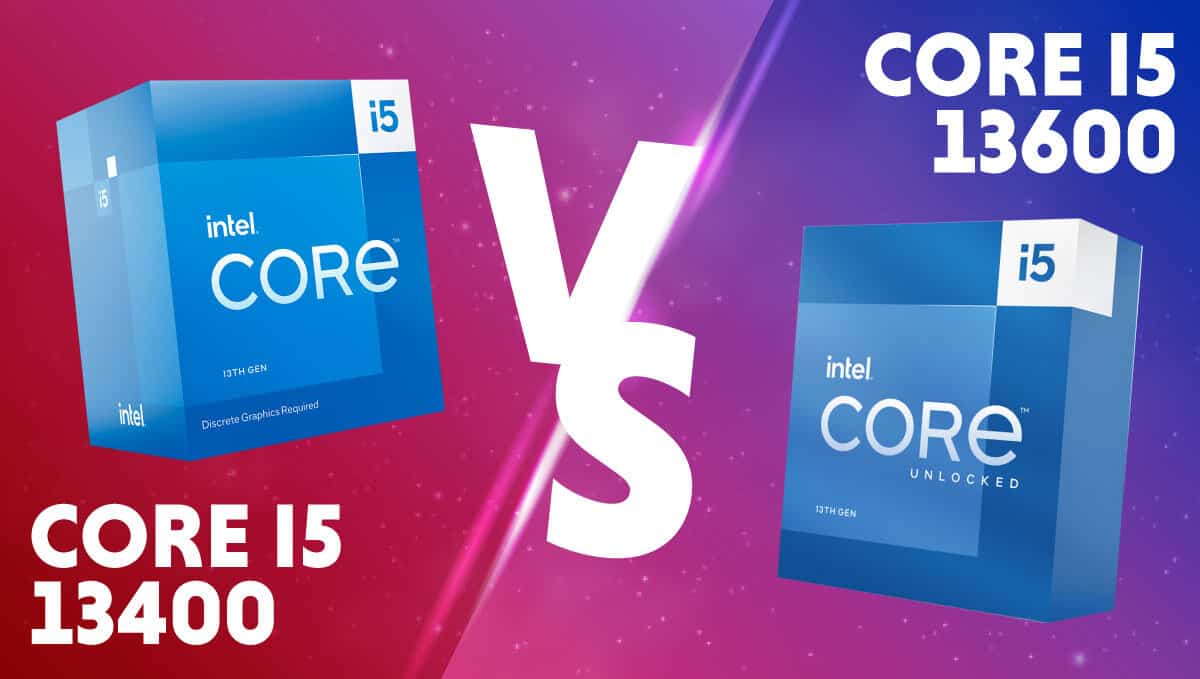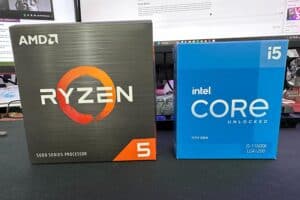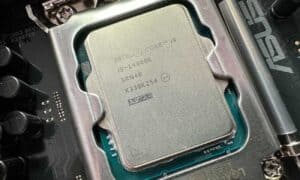Intel Core i5-13400 vs Core i5-13600
Intel Core i5-13400 vs Core i5-13600. Which is better?

WePC is reader-supported. When you buy through links on our site, we may earn an affiliate commission. Prices subject to change. Learn more
The 13400 and 13600 processors both belong to Intel’s Core i5 series. They are both among the newest CPU releases, having hit the markets only recently in January. Here’s our Intel Core i5-13400 vs Core i5-13600 article.
Now read: Is the Intel Core i5-13400 good for gaming?
Since they are both i5 processors, they offer very similar specs, and it can be a bit confusing to differentiate between them.
Today, we’re examining their differences under the microscope to determine which of the two is the better processor performance-wise and which offers better value for money. This is Intel Core i5-13400 vs i5-13600.
Intel Core i5-13400 vs Core i5-13600: Specifications
Before we begin with our comparison, let’s go over both CPUs’ specs so we have a better understanding of what we’re working with.
Intel Core i5-13400
- 10 Cores / 16 Threads
- 6 Performance Cores with Hyperthreading (12 Threads)
- 4 Efficiency Cores (4 Threads)
- P.Core Base Clock: 2.5 GHz
- P.Core Boost Clock: 4.6 GHz
- E.Core Base Clock: 1.8 GHz
- E.Core Boost Clock: 3.3 GHz
- L2 Cache: 9.5 MB
- L3 Cache (shared): 20MB
- Default TDP: 65W
- Maximum TDP: 154W
Here’s some more on the i5-13400.
Intel Core i5-13600
- 14 Cores / 20 Threads
- 6 Performance Cores with Hyperthreading (12 Threads)
- 8 Efficiency Cores (8 Threads)
- P.Core Base Clock: 2.7 GHz
- P.Core Boost Clock: 5.0 GHz
- E.Core Base Clock: 2.0 GHz
- E.Core Boost Clock: 3.7 GHz
- L2 Cache: 11.5MB
- L3 Cache (shared): 24MB
- Default TDP: 65W
- Maximum TDP: 154W
Learn more about the i5-13600 here.
Intel Core i5-13400 vs Core i5-13600: Comparison
As obvious from the above specs, both processors are somewhat similar. The few key differences between them lie in the clock speeds, the core count, and the amount of available cache.
Core Clock
A processor’s core clock refers to the frequency with which it’s able to complete its fetch-execute cycle in a single second.
CPUs work by fetching instructions from the system’s memory, decoding these instructions to make sense of them, and then executing them.
Instructions are executed one at a time. This process is just carried out so fast that the processor is quickly able to serve the various tasks you’re sending its way.
A processor with a clock speed of 3GHz, for example, is able to execute 3 billion instructions per second.
The 13400 has a max clock speed of 4.6GHz. This frequency is reached when the processor is under load.
The 13600, on the other hand, has a 5.0GHz max clock speed. This 400MHz is enough to cause a noticeable difference in performance, especially in single-core heavy workloads such as gaming. The 13600 is simply the faster processor.
I should mention that we’ve only compared the max clock speed here since, honestly, that’s the only clock metric that really matters.
The base clock speed is inconsequential to performance when the processor is under load since it will be running at its highest manageable clock speed, which is very close to the max clock listed in the specs.
Core/Thread count
Both CPUs feature Intel’s hybrid core architecture. That means you’ll find both performance and efficiency cores within the processor die.
The 13400 is a 10-core, 16-thread processor. The 13600 is a 14-core, 20-thread processor. However, really the only difference here is that the 13600 has 4 extra efficiency cores.
Both processors have an identical amount of performance cores – 6.
The 4 extra efficiency cores possessed by the 13600 do matter, of course, even if they are smaller cores. And you have to consider the fact that each of the 13600’s cores is running at a higher clock speed.
Ultimately, the 13600 outperforms the 13400k in multicore performance (when all of the processor’s resources are being utilized) by a considerable margin of 20 to 30%.
Cache
A processor’s cache is high-speed memory located directly on or right next to the die. This memory stores high-importance data frequently required by the CPU, so it doesn’t have to access the much slower RAM for the data instead.
The 13600 has a 24MB shared cache, which is just slightly higher than the 13400’s 20MB. That’s a minor difference, one that it’s hard to attribute any variations in performance to.
Intel Core i5-13400 vs Core i5-13600: Price
The i5-13400 has an MSRP of $221, and it’s available for around the same price today. The 13600 is, as you would expect, slightly more expensive at a $255 MSRP.
Both processors are excellent mid-range options.
Final thoughts
The i5-13600 is the clear winner in terms of raw performance here. It outperforms the 13400 in both single-thread and multithreaded workloads due to a higher clock speed and 4 extra physical cores.
In terms of value, the 13400 is likely the better of the two. But not by much; the 13600’s higher cost is well-justified by its incredible performance.
If your primary concern is gaming, the 13600 won’t offer you much practical improvement over the 13400, so it’s okay to go with the latter and save some money.
However, if you would benefit from having the additional cores for productivity or content creation, the 13600 is well worth the purchase.
You may even consider going for the unlockable i5-13600K – the most popular variant of the 13600 processor.




